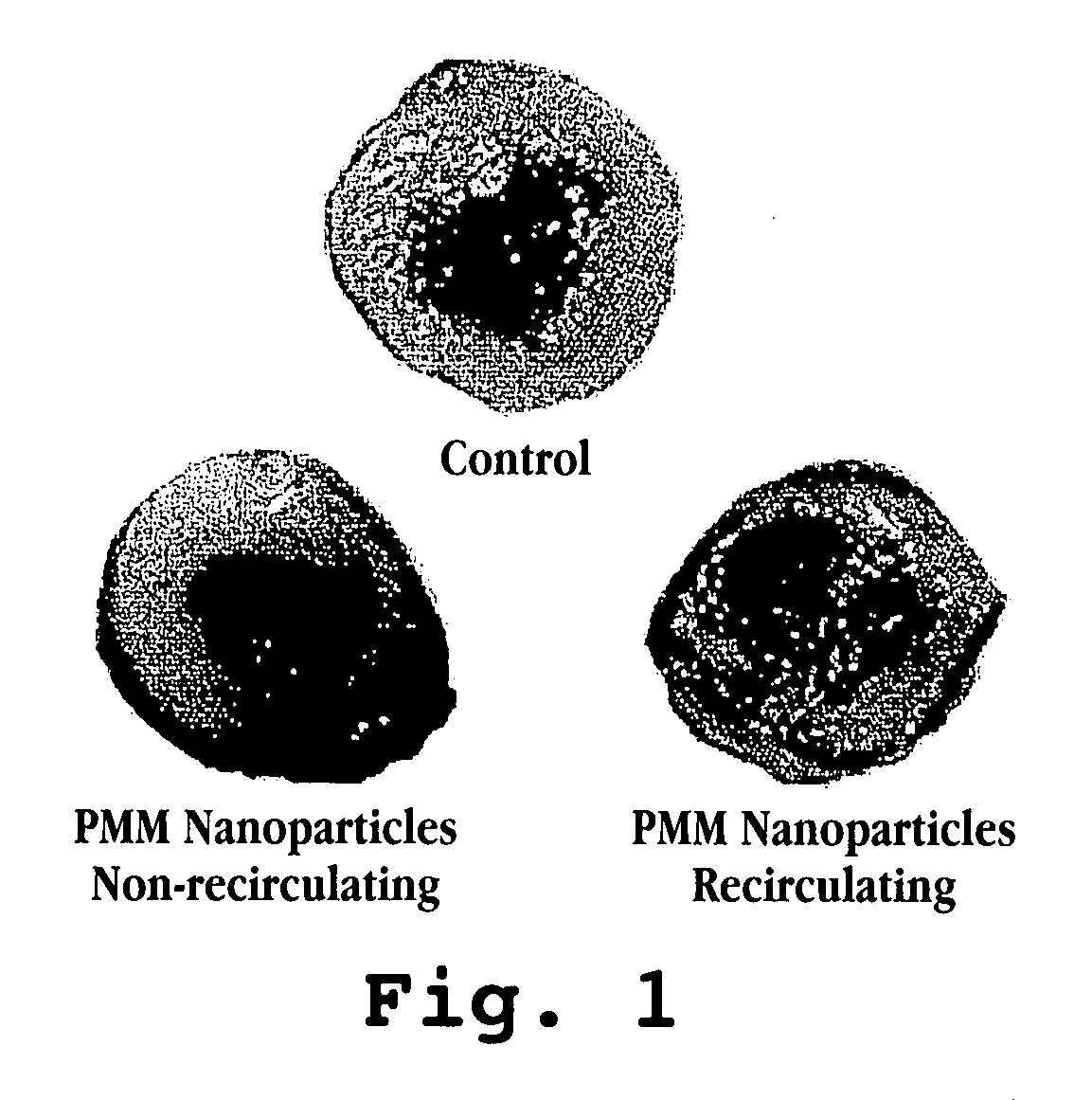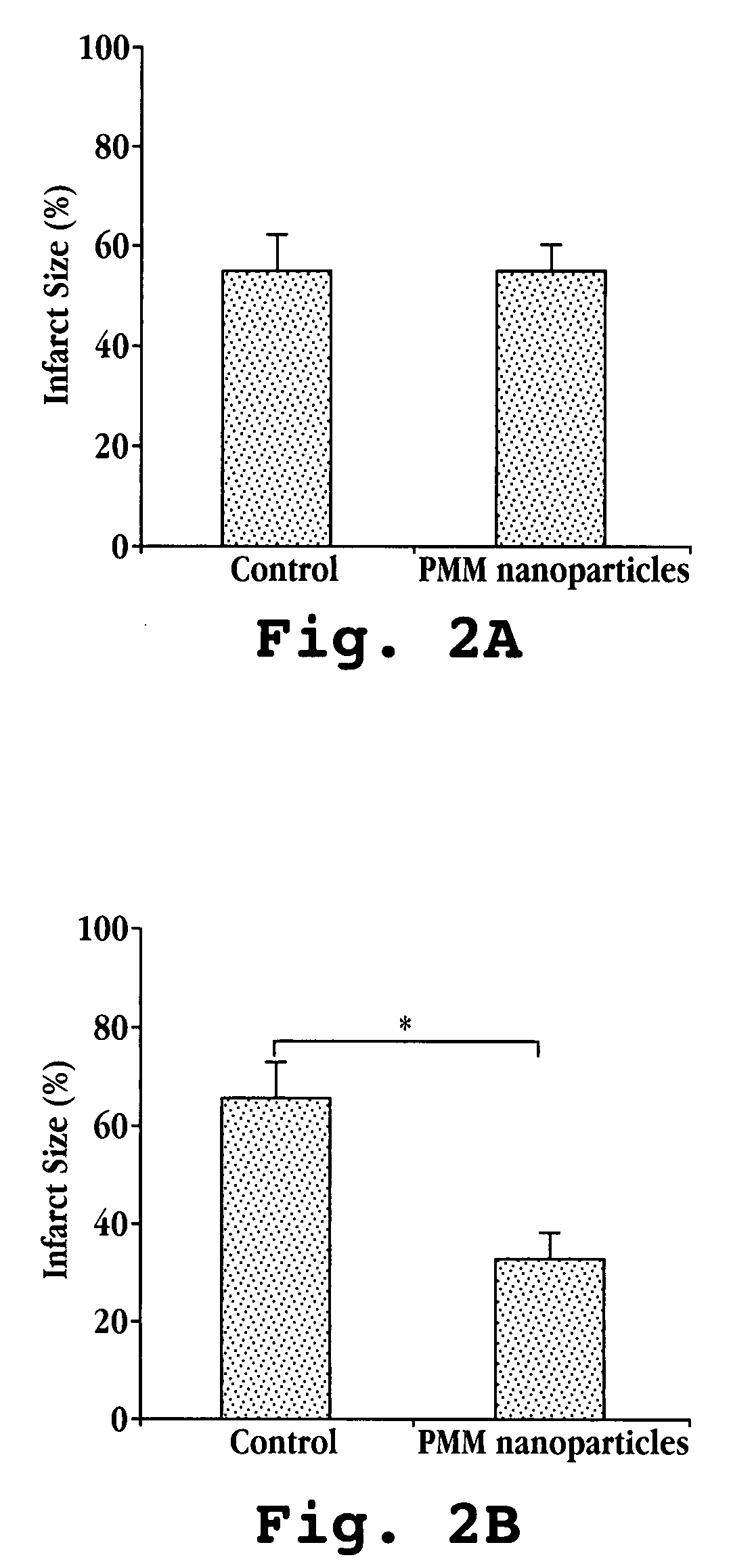Method and use of nano-scale devices for reduction of tissue injury in ischemic and reperfusion injury
a technology of nano-scale devices, which is applied in the direction of cardiovascular disorders, synthetic polymeric active ingredients, drug compositions, etc., can solve the problems of increased tissue stress, worsening damage, and inability and death, and achieve the effect of reducing ischemic and reperfusion injury
- Summary
- Abstract
- Description
- Claims
- Application Information
AI Technical Summary
Benefits of technology
Problems solved by technology
Method used
Image
Examples
example 1
Nanodevices for Reducing Ischemic Injury
[0048] The present example shows that reduced tissue damage was achieved in a rat heart subject to ex vivo ischemia and reperfusion injury by treating the heart with nanoparticles.
[0049] A. Materials
[0050] Male Sprague-Dawley rats (280-380 g; n=4-5 per group) were used for ex vivo cardiac ischemia and reperfusion. PMM nanoparticles were synthesized via polymerization of poly(methylidene malonate 2.1.2 monomer as described previously (Breton, P. et al., Biomaterials, 19(1-3):271 (1998)). Polymer was delivered at 1×106 particles / mL to the heart.
[0051] B. Methods
[0052] To mimic acute myocardial infarction, an ex vivo Langendorff cardiac ischemia / reperfusion model was used. Working hearts were extracted from deeply anesthetized animals and rapidly cannulized. Oxygenated, warmed Krebs buffer was perfused in a retrograde fashion through the hearts via the aorta to maintain tissue viability. To mimic ischemia, perfusion of the oxygenated buffer ...
example 2
Identification of Optimal Surface Characteristics of Nanodevices
[0058] Nanodevices having surface characteristic optimal for delivering and releasing therapeutic agents (i.e., drugs) are determined by testing a series of nanodevices, e.g., in the animal model described in Example 1.
[0059] In one experiment, the following nanodevices are tested.
Nanodevices with differing surface characteristics will be evaluated forcardioprotective effectsSurface characteristicsSizeNameFluorophore (λ)Negative charge0.5 μmPMM 2.1.2580 / 605Positive charge0.2 μmFS amine580 / 605Positive charge1.0 μmFS amine505 / 515Carboxylate modified0.2 μmFS carboxylate580 / 605Carboxylate modified0.5 μmFS carboxylate580 / 605Carboxylate modified1.0 μmFS carboxylate580 / 605
[0060] Each nanodevice is tested as described, e.g., in Example 1, with results being determined by measuring the levels of cardiac enzymes released in the buffer effluent (a measure of oncosis) as well as by staining with triphenyl tetrazolium chloride (...
example 3
Measuring Adenosine Concentration in Cardiac Tissue
[0063] Preliminary studies suggest that nanodevices protect allografts via an adenosine receptor-dependent mechanism. However, the short half-life of adenosine (<1 second in the blood) makes studying this mechanism problematic. An inhibitor of adenosine deaminase (the enzyme responsible for degradation of adenosine and used for snap freezing) is used to facilitate study the mechanism. Briefly, hearts are perfused with cardioprotective nanoparticles for 2 minutes. A cold 15G needle is used to collect biopsy samples every 30 seconds. The biopsy samples are snap frozen in tubes containing extraction buffer (0.4 M perchloric acid) and 280 μM deaminase inhibitor (e.g., erythro-9(2-hydroxy-3-nonyl)adenine; EHNA. Following two freeze / thaw cycles, shaking, and centrifugation, the samples are loaded onto a reverse-phase HPLC column to separate adenosine from other nucleotide catabolites. Samples are normalized to an adenosine standard and t...
PUM
| Property | Measurement | Unit |
|---|---|---|
| time | aaaaa | aaaaa |
| time | aaaaa | aaaaa |
| time | aaaaa | aaaaa |
Abstract
Description
Claims
Application Information
 Login to View More
Login to View More - R&D
- Intellectual Property
- Life Sciences
- Materials
- Tech Scout
- Unparalleled Data Quality
- Higher Quality Content
- 60% Fewer Hallucinations
Browse by: Latest US Patents, China's latest patents, Technical Efficacy Thesaurus, Application Domain, Technology Topic, Popular Technical Reports.
© 2025 PatSnap. All rights reserved.Legal|Privacy policy|Modern Slavery Act Transparency Statement|Sitemap|About US| Contact US: help@patsnap.com



